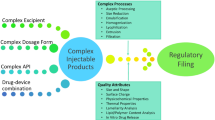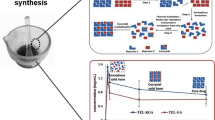Abstract
Objective
Raltegravir potassium (RP) exhibits very low water solubility over the range of physiological pH (1.2, 4.5, and 6.8), which leads to poor dissolution properties and ultimately high intra- and inter-patient variabilities. The present research work aimed to prepare RP-loaded solid self-microemulsifying drug delivery system (S-SMEDDS) of RP to improve its dissolution characteristics.
Methods
Based on results of drug solubilization capacity and emulsification efficiency, labrasol, Tween-20, and PEG-400 were selected as oil, emulsifier, and co-emulsifier, respectively. A ternary phase diagram was generated to identify the proportion of compositions that, upon mixing, formed a clear and transparent microemulsion. In the present investigation, simplex lattice design was used to explore the effect of variations in the composition of excipients on significant formulation characteristics.
Result
The regression analysis suggested a significant effect of the change in the proportion of composition on selected response variables. Optimized SMEDDS formulation was mixed with selected carriers in a mortar to prepare S-SMEDDS. The results of DSC and powder X-ray diffraction studies indicated the complete transformation of the crystalline drug into the amorphous or molecular level dispersed form when neusiline US2 was used as a carrier.
Conclusion
The results of in vitro dissolution studies proved significant improvement in the dissolution properties from the S-SMEDDS formulation compared to the pure drug (f2 < 50).
Graphical Abstract










Similar content being viewed by others
References
Serrao E, Odde S, Ramkumar K, Neamati N. Raltegravir, elvitegravir, and metoogravir: the birth of “me-too” HIV-1 integrase inhibitors. Retrovirology. 2009;6(1):1–14.
Krishna R, Rizk ML, Larson P, Schulz V, Kesisoglou F, Pop R. Single-and multiple-dose pharmacokinetics of once-daily formulations of raltegravir. Clin Pharm Drug Dev. 2018;7(2):196–206.
Saal C, Becker A. Pharmaceutical salts: a summary on doses of salt formers from the Orange Book. Eur J Pharm Sci. 2013;49(4):614–23.
Gigante V, Pauletti GM, Kopp S, Xu M, Gonzalez-Alvarez I, Merino V, et al. Global testing of a consensus solubility assessment to enhance robustness of the WHO biopharmaceutical classification system. ADMET and DMPK. 2021;9(1):23–39.
Cattaneo D, Baldelli S, Cerea M, Landonio S, Meraviglia P, Simioni E, et al. Comparison of the in vivo pharmacokinetics and in vitro dissolution of raltegravir in HIV patients receiving the drug by swallowing or by chewing. Antimicrob Agents Chemother. 2012;56(12):6132–6.
Cattaneo D, Gervasoni C, Meraviglia P, Landonio S, Fucile S, Cozzi V, et al. Inter- and intra-patient variability of raltegravir pharmacokinetics in HIV-1-infected subjects. J Antimicrob Chemother. 2012;67(2):460–4.
Dokania S, Joshi AK. Self-microemulsifying drug delivery system (SMEDDS)–challenges and road ahead. Drug Deliv. 2015;22(6):675–90.
Charman WN, Stella VJ. Transport of lipophilic molecules by the intestinal lymphatic system. Adv Drug Deliv Rev. 1991;7(1):1–14.
Nazzal S, Wang Y. Characterization of soft gelatin capsules by thermal analysis. Int J Pharm. 2001;230(1–2):35–45.
Chang RK, Raghavan KS, Hussain MA. A study on gelatin capsule brittleness: moisture tranfer between the capsule shell and its content. J Pharm Sci. 1998;87(5):556–8.
Yi T, Wan J, Xu H, Yang X. A new solid self-microemulsifying formulation prepared by spray-drying to improve the oral bioavailability of poorly water soluble drugs. Eur J Pharm Biopharm. 2008;70(2):439–44.
Jannin V, Musakhanian J, Marchaud D. Approaches for the development of solid and semi-solid lipid-based formulations. Adv Drug Deliv Rev. 2008;60(6):734–46.
Tang B, Cheng G, Gu J-C, Xu C-H. Development of solid self-emulsifying drug delivery systems: preparation techniques and dosage forms. Drug Discov Today. 2008;13(13–14):606–12.
Sanka K, Suda D, Bakshi V. Optimization of solid-self nanoemulsifying drug delivery system for solubility and release profile of clonazepam using simplex lattice design. Drug Deliv Sci Technol. 2016;33:114–24.
Dhaval M, Panjwani M, Parmar R, Soniwala MM, Dudhat K, Chavda J. Application of simple lattice design and desirability function for formulating and optimizing SMEDDS of clofazimine. J Pharm Innov. 2021;16(3):504–15. https://doi.org/10.1007/s12247-020-09468-8.
Dhaval M, Devani J, Parmar R, Soniwala MM, Chavda J. Formulation and optimization of microemulsion based sparfloxacin in-situ gel for ocular delivery: in vitro and ex vivo characterization. J Drug Delivery Sci Technol. 2020;55:101373. https://doi.org/10.1016/j.jddst.2019.101373.
Wang Y, Sun J, Zhang T, Liu H, He F, He Z et al. Enhanced oral bioavailability of tacrolimus in rats by self-microemulsifying drug delivery systems. 2011;37(10):1225–30.
Snela A, Jadach B, Froelich A, Skotnicki M, Milczewska K, Rojewska M, et al. Self-emulsifying drug delivery systems with atorvastatin adsorbed on solid carriers: formulation and in vitro drug release studies. 2019;577:281–90.
Madan JR, Patil K, Awasthi R, Dua K. Formulation and evaluation of solid self-microemulsifying drug delivery system for azilsartan medoxomil. Int J Polym Mater Polym Biomater. 2021;70(2):100–16. https://doi.org/10.1080/00914037.2019.1695206.
Vadlamudi HC, Yalavarthi PR, Nagaswaram T, Rasheed A, Peesa JP. In-vitro and pharmacodynamic characterization of solidified self microemulsified system of quetiapine fumarate. J Pharm Investig. 2019;49(1):161–72.
Dangre PV, Gilhotra RM, Dhole SN. Formulation and development of solid self micro-emulsifying drug delivery system (S-SMEDDS) containing chlorthalidone for improvement of dissolution. J Pharm Investig. 2016;46(7):633–44.
Dalvadi H, Patel N, Parmar K. Systematic development of design of experiments (DoE) optimised self-microemulsifying drug delivery system of Zotepine. J Microencapsul. 2017;34(3):308–18.
Cattaneo D, Baldelli S, Cerea M, Landonio S, Meraviglia P, Simioni E, et al. Comparison of the in vivo pharmacokinetics and in vitro dissolution of raltegravir in HIV patients receiving the drug by swallowing or by chewing. Antimicrob Agents Chemother. 2012;56(12):6132–6.
Cirri M, Mura P, Mora PC. Liquid spray formulations of xibornol by using self-microemulsifying drug delivery systems. Int J Pharm. 2007;340(1–2):84–91.
Sha X, Yan G, Wu Y, Li J, Fang X. Effect of self-microemulsifying drug delivery systems containing Labrasol on tight junctions in Caco-2 cells. Eur J Pharm Sci. 2005;24(5):477–86.
Ghosh PK, Majithiya RJ, Umrethia ML, Murthy RSR. Design and development of microemulsion drug delivery system of acyclovir for improvement of oral bioavailability. AAPS PharmSciTech. 2006;7(3):E172–7.
Piao H-M, Cho H-J, Oh E-C, Chung S-J, Shim C-K, Kim D-D. Budesonide microemulsions for enhancing solubility and dissolution rate. J Pharm Investig. 2009;39(6):417–22.
Li L, Yi T, Lam CW-K. Effects of spray-drying and choice of solid carriers on concentrations of Labrasol® and Transcutol® in solid self-microemulsifying drug delivery systems (SMEDDS). Molecules. 2013;18(1):545–60.
Callender SP, Mathews JA, Kobernyk K, Wettig SD. Microemulsion utility in pharmaceuticals: implications for multi-drug delivery. Int J Pharm. 2017;526(1–2):425–42.
Negi JS. Nanolipid materials for drug delivery systems: a comprehensive review. Character Biol Nanomater Drug Deliv. 2019:137–63.
Chen S, Hanning S, Falconer J, Locke M, Wen J. Recent advances in non-ionic surfactant vesicles (niosomes): fabrication, characterization, pharmaceutical and cosmetic applications. Eur J Pharm Biopharm. 2019;144:18–39.
Biruss B, Valenta C. The advantage of polymer addition to a non-ionic oil in water microemulsion for the dermal delivery of progesterone. Int J Pharm. 2008;349(1–2):269–73.
Masjedi M, Montahaei T. An illustrated review on nonionic surfactant vesicles (Niosomes) as an approach in modern drug delivery: fabrication, characterization, pharmaceutical, and cosmetic applications. J Drug Delivery Sci Technol. 2020:102234.
Zhang P, Liu Y, Feng N, Xu J. Preparation and evaluation of self-microemulsifying drug delivery system of oridonin. Int J Pharm. 2008;355(1–2):269–76.
Ghosh PK, Murthy RSR. Microemulsions: a potential drug delivery system. Curr Drug Deliv. 2006;3(2):167–80.
Djekic L, Primorac M. The influence of cosurfactants and oils on the formation of pharmaceutical microemulsions based on PEG-8 caprylic/capric glycerides. Int J Pharm. 2008;352(1–2):231–9.
Bahl D, Bogner RH. Amorphization of indomethacin by co-grinding with Neusilin US2: amorphization kinetics, physical stability and mechanism. Pharm Res. 2006;23(10):2317–25.
Dedroog S, Pas T, Vergauwen B, Huygens C, Van den Mooter G. Solid-state analysis of amorphous solid dispersions: why DSC and XRPD may not be regarded as stand-alone techniques. J Pharm Biomed Anal. 2020;178:112937.
Madagul JK, Parakh DR, Kumar RS, Abhang RR. Formulation and evaluation of solid self-microemulsifying drug delivery system of chlorthalidone by spray drying technology. Drying Technol. 2017;35(12):1433–49.
Dangre P, Gilhotra R, Dhole S. Formulation and statistical optimization of self-microemulsifying drug delivery system of eprosartan mesylate for improvement of oral bioavailability. Drug Deliv Transl Res. 2016;6(5):610–21.
Qureshi MJ, Mallikarjun C, Kian WG. Enhancement of solubility and therapeutic potential of poorly soluble lovastatin by SMEDDS formulation adsorbed on directly compressed spray dried magnesium aluminometasilicate liquid loadable tablets: a study in diet induced hyperlipidemic rabbits. Asian J Pharm Sci. 2015;10(1):40–56.
Laitinen R, Löbmann K, Strachan CJ, Grohganz H, Rades T. Emerging trends in the stabilization of amorphous drugs. Int J Pharm. 2013;453(1):65–79.
Kim DW, Kwon MS, Yousaf AM, Balakrishnan P, Park JH, Kim DS, et al. Comparison of a solid SMEDDS and solid dispersion for enhanced stability and bioavailability of clopidogrel napadisilate. Carbohyd Polym. 2014;114:365–74.
Oh DH, Kang JH, Kim DW, Lee B-J, Kim JO, Yong CS, et al. Comparison of solid self-microemulsifying drug delivery system (solid SMEDDS) prepared with hydrophilic and hydrophobic solid carrier. Int J Pharm. 2011;420(2):412–8.
Jaydip B, Dhaval M, Soniwala MM, Chavda J. Formulation and optimization of liquisolid compact for enhancing dissolution properties of efavirenz by using DoE approach. Saudi Pharm J. 2020;28(6):737–45.
Funding
The Department of Technical Education, Government of Gujarat, India, has given financial assistance under the SSIP (Student Startup & Innovation Policy) scheme for this project.
Author information
Authors and Affiliations
Corresponding author
Ethics declarations
Ethical Statement
No animals or humans were harmed during the course of this research work.
Conflict of Interest
The authors declare no competing interests.
Additional information
Publisher's Note
Springer Nature remains neutral with regard to jurisdictional claims in published maps and institutional affiliations.
Supplementary Information
Below is the link to the electronic supplementary material.
Rights and permissions
About this article
Cite this article
Jain, S., Dudhat, K., Soniwala, M.M. et al. DoE-Based Solid Self-microemulsifying Drug Delivery System (S-SMEDDS) Approach for Improving the Dissolution Properties of Raltegravir Potassium. J Pharm Innov 18, 29–42 (2023). https://doi.org/10.1007/s12247-022-09621-5
Accepted:
Published:
Issue Date:
DOI: https://doi.org/10.1007/s12247-022-09621-5




